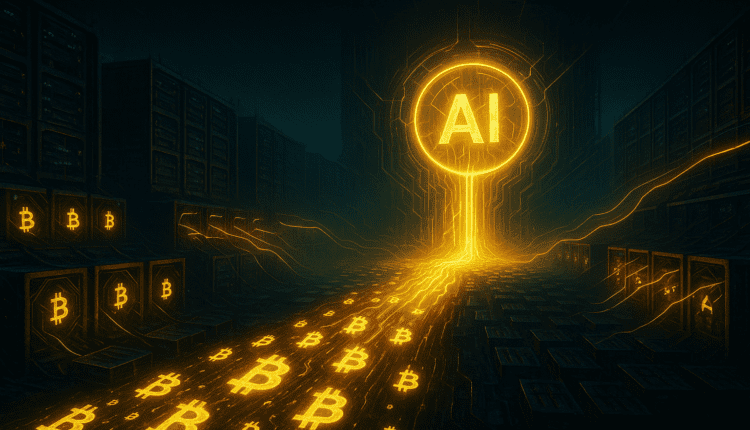Bitcoin Mining Profits Slump — Will AI Computing Save the Sector?

The economics of Bitcoin (BTC) mining are once again under pressure. Recent data shows that hashprice — the industry key profitability metric — has dropped to multi-month lows as energy costs rise and market competition intensifies. For miners, this signals a turning point: either adapt through efficiency and AI-driven computing, or risk being pushed out of the game.
You can explore more updates and in-depth analysis in our dedicated Bitcoin News section.
⚙️ Hashprice Hits Multi-Month Low: A Reality Check for Miners
Online advertising service 1lx.online
At the same time, Bitcoin’s price has traded mostly sideways around the $107K–$109K range, squeezing margins even further.
The network’s difficulty recently hit a record high above 89 trillion, meaning miners must now commit unprecedented power to earn the same rewards.
For small and mid-tier operators, this environment has become economically brutal — with some already powering down unprofitable rigs or redirecting infrastructure toward AI and high-performance computing (HPC).
“The hashprice compression we’re seeing now mirrors late-cycle stress,” said a mining analyst at Luxor. “Only miners that innovate — either via efficiency or diversification — will survive the next phase.”
🧠 From Mining Farms to AI Compute Centers
This profitability squeeze is accelerating a structural transformation.
Leading operators are repurposing their facilities to host AI workloads, effectively merging the mining and data-compute industries.
Recent deals, like Cipher Mining’s 15-year contract with Amazon Web Services for 300 MW of compute capacity, demonstrate how mining hardware and infrastructure can pivot into the AI compute economy.
AI and machine-learning models demand massive parallel processing — something mining farms are already optimized for. By integrating GPU clusters and hybrid AI/HPC frameworks, miners can offset falling Bitcoin income with new revenue streams from AI training and cloud compute leasing.
According to on-chain and infrastructure data, around 12 % of U.S. mining facilities have already begun allocating part of their power capacity to AI contracts or data-intensive tasks.
“Mining and AI are converging faster than people think,” noted @skewdotcom. “The same megawatts that mint Bitcoin today could train large language models tomorrow.”
You can find related infrastructure analysis in our Cryptocurrency News coverage of AI-driven blockchain transformation.
Online advertising service 1lx.online
📉 Economic Pressure Mounts: Costs vs. Capacity
Despite these diversification efforts, miners face mounting cost pressure:
- Electricity prices in major jurisdictions (Texas, Kazakhstan, Scandinavia) have risen by 20 – 35 % over the past year.
- Hardware upgrades (S21, M60, Whatsminer M66) cost more than ever, pushing capital recovery periods beyond 24 months.
- Network difficulty continues to scale, driven by institutional entrants and nation-state operations expanding their fleets.
According to Glassnode, miner balances have decreased by roughly 5 % since September 2025, suggesting some are liquidating BTC reserves to sustain operations or finance infrastructure conversions.
Meanwhile, exchange inflow data from CryptoQuant shows modest upticks from known miner wallets — a classic sign of profit stress.
These on-chain metrics indicate that margin compression is real, and diversification into AI may not be optional — it’s existential.
Online advertising service 1lx.online
🔋 Technical Setup & Long-Term Outlook
Technically, Bitcoin’s mining difficulty adjustment is expected to ease slightly by mid-November, offering minor relief.
However, the 2026 halving — which will slash block rewards from 3.125 BTC to 1.5625 BTC — looms as the next major stress test.
To stay competitive, miners are betting on:
- AI compute integration to stabilize income.
- Renewable and low-cost energy sources for long-term sustainability.
- Advanced cooling and chip optimization to maintain efficiency per watt.
If these transitions succeed, mining could evolve from a narrow crypto-centric model to a multi-revenue digital infrastructure industry, blending blockchain validation, cloud computing, and artificial intelligence.
As analysts increasingly refer to this evolution as the “compute economy”, miners are no longer just securing Bitcoin — they’re powering the next wave of technological transformation.
Our creator. creates amazing NFT collections!
Support the editors - Bitcoin_Man (ETH) / Bitcoin_Man (TON)
Pi Network (Guide)is a new digital currency developed by Stanford PhDs with over 55 million participants worldwide. To get your Pi, follow this link https://minepi.com/Tsybko and use my username (Tsybko) as the invite code.
Binance: Use this link to sign up and get $100 free and 10% off your first months Binance Futures fees (Terms and Conditions).
Bitget: Use this link Use the Rewards Center and win up to 5027 USDT!(Review)
Bybit: Use this link (all possible discounts on commissions and bonuses up to $30,030 included) If you register through the application, then at the time of registration simply enter in the reference: WB8XZ4 - (manual)
